5 Mins Read
Techstyle and agrifood innovation platform The Mills Fabrica has released a new report detailing the role and impact of single-use plastic packaging in the fashion and food sectors. Rethink Packaging is designed to act as a guide for brands looking to address the issue, by taking into account the full life cycle of existing packaging solutions.
The report is the conclusion of a six-month research project, which included multiple in-depth interviews with brands to better understand how they are tackling packaging’s environmental impact across their supply chains, and offers insight into the challenges facing companies seeking to remove single-use plastic from their value chain. The resulting guide suggests a holistic approach to packaging use is the best way forward, taking materials, reduction and end-of-life initiatives into account.

The problem with plastic packaging
Plastic packaging might have become a recognised norm but its impact is now widely understood. With cognisance comes a responsibility to eliminate harmful materials from the supply chain, in favour of easily recycled and low-impact alternatives. Since the 1950s, around 8.3 billion metric tonnes of plastic has been manufactured. Less than 9 percent gets recycled, with today’s manufacturing still geared towards single-use products.
Microplastics, thought to come from plastic in landfill, were discovered in human bloodstreams for the first time last month, with the potential to lodge in internal organs. The particles cause damage to human cells and are considered hazardous to health. Discovery of them in the bloodstream has revived a call for the redoubling of efforts to remove plastic from the global supply chain.

Cracking down on plastic packaging users
Governments are looking to ban single-use plastics, or at least make it unappealing from a commercial standpoint. Previously, plastic has been popular due to its low cost and versatility. Now, as plastic packaging tax initiatives begin, brands are highlighting the difficulties they face in removing it from their supply chain.
Rethink Packaging identifies challenges, suggests alternative materials and discloses techniques for overcoming obstacles. It offers pragmatic solutions that allow for immediate adaptations before medium-long term solutions can be rolled out. Overall, it paints a picture of an evolving landscape that will hopefully bring together economic and environmental concerns for companies within the fashion and agrifood industries.

The need for a holistic approach
The Mills Fabrica recommends looking at packaging in its constituent parts. Starting with the production and materials selected, it asks whether bio-based alternatives are a feasible option. Can the design process lend itself to frugal material needs and impact? Moving through to distribution centres, the report asks brands to look at if they can use packaging less and if logistics systems can support such a reduction. Finally, it comes to how the consumer supports different packaging solutions with their purchasing power and the ease of end-of-life disposal.
Understanding that removing all plastic is a high mantle, the report addresses gradual processes. It identifies that most brands go through stages of increasing the number of recycled materials in their packaging, before looking at across-the-board- bio-based alternatives, redesigning everything and finally, working together. Despite being positive moves, these all face hurdles.

Challenges facing plastic removers
Inconsistent infrastructure for packing disposal remains an issue. Globally, plastic recycling takes many forms, with not all cities able to cope with bio-based materials. This leads to experiments with a variety of materials, including paper packaging, which can prove unsuitable, more costly and harder to mass-produce. Finally, despite plastic taxes coming in, brands have been explicit about the lack of incentives to move to fully recyclable or biodegradable packaging.
Bio-based plastics are being cited as potential solutions. They should mimic the versatility of single-use counterparts while being entirely biodegradable. However, they remain new and their longevity and functionality remain unproven. This represents uncertainty for large-scale brands considering their environmental footprint.

The best course of action to move away from plastic packaging
Rethink Packaging concludes by suggesting that a gradual but considered approach to ditching single-use plastic packaging is best. This should start with product designs. By developing packaging that requires less material to start with, positive inroads can be made. This will naturally lead to the incentivisation of similar change in all stakeholder activities. Medium-long term steps are cited as including testing the viability of low-impact materials and finally, piloting selected options to scale up.
To successfully move away from single-use plastic permanently, the report underlines the importance of cross-pollination, with three-fold collaboration between suppliers, brands and customers deemed essential for meaningful progress.
Download the Rethink Packaging report by The Mills Fabrica.
All visuals and diagrams supplied by The Mills Fabrica. Lead Photo courtesy of Sulapac.
This is a Green Queen Partner Post.





